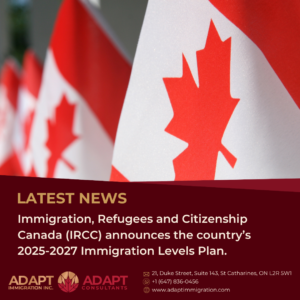IRCC announces the country’s 2025-2027 Immigration Levels Plan

Immigration, Refugees and Citizenship Canada (IRCC) has unveiled the highly anticipated 2025-2027 Immigration Levels Plan, marking a significant shift in how Canada manages both permanent and temporary residents. This new plan outlines detailed targets for permanent resident admissions, while also, for the first time, establishing clear goals for temporary residents such as international students and temporary foreign workers. Here’s an in-depth look at the key highlights of this comprehensive plan.
Permanent Resident Admissions: A Gradual Decline
The new Levels Plan projects a gradual decline in permanent resident admissions over the next three years. By 2027, the target will drop to 365,000 from 395,000 in 2025 and 380,000 in 2026. While this decrease might seem modest, it reflects IRCC’s intent to balance intake with broader economic and social goals. This strategic reduction allows the Canadian government to fine-tune its immigration policies, ensuring sustainable growth while addressing labor market demands.
| Year | Projected Admissions |
|---|---|
| 2025 | 395,000 |
| 2026 | 380,000 |
| 2027 | 365,000 |
First-Ever Targets for Temporary Residents
In an unprecedented move, IRCC has introduced specific targets for temporary residents, recognizing their crucial role in Canada’s economic and social fabric. The intake of international students and temporary foreign workers will help address labor shortages and foster a robust, skilled workforce. Below are the targets for temporary resident intake from 2025 to 2027.
| Year | Overall Arrivals | Workers (Total) | International Mobility Program | Temporary Foreign Worker Program | Students |
|---|---|---|---|---|---|
| 2025 | 673,650 | 367,750 | 285,750 | 82,000 | 305,900 |
| 2026 | 516,600 | 210,700 | 128,700 | 82,000 | 305,900 |
| 2027 | 543,600 | 237,700 | 155,700 | 82,000 | 305,900 |
Economic Category to Dominate: Nearly 62% by 2027
The economic category will continue to lead in terms of overall admissions, accounting for nearly 62% of the total by 2027. This focus is aligned with Canada’s need to attract skilled workers who can drive economic growth and innovation. Skilled immigrants are crucial in sectors such as health care and skilled trades, which are currently facing labor shortages. The plan’s “Federal Economic Priorities” places significant weight on recruiting individuals who can fill these gaps, ensuring the country’s economic future is secured.
Supporting Critical Sectors: Health Care and Skilled Trades
As part of its economic strategy, the 2025-2027 Levels Plan prioritizes admissions for skilled workers in critical sectors, particularly health care and skilled trades. These industries are essential to Canada’s well-being and economic stability, and the IRCC aims to fill labor shortages with qualified professionals. The focus on these sectors under the “Federal Economic Priorities” reflects the importance of long-term planning to support industries vital to Canada’s growth and development.
“In-Canada Focus” for Transitioning Students and Workers
A key element of this plan is the emphasis on transitioning temporary residents—particularly international students and temporary foreign workers—into permanent residents. Known as the “in-Canada focus,” this approach aims to facilitate the smooth transition of individuals already contributing to the country’s economy and society. By encouraging the retention of these individuals, Canada stands to benefit from their skills and knowledge, ensuring a strong, diverse, and stable workforce for years to come.
Family Reunification: Steady at 22%
Family reunification remains a priority, with this category continuing to account for 22% of overall admissions throughout the three-year plan. Canada’s immigration policies have long emphasized the importance of keeping families together, which strengthens communities and fosters social stability. The steady commitment to family reunification demonstrates the country’s dedication to humanitarian values and to creating welcoming, supportive environments for newcomers.
Refugees and Protected Persons: 15% of Overall Admissions
Canada’s proud tradition of providing refuge to those in need remains a central pillar of the immigration plan. The refugee and protected persons category will maintain 15% of total permanent resident admissions. This commitment underscores Canada’s role in global humanitarian efforts, offering protection to individuals fleeing persecution and danger. Over the next three years, IRCC will continue to provide opportunities for resettlement and safety, contributing to Canada’s reputation as a compassionate and inclusive nation.
Humanitarian and Compassionate Grounds: 21,200 Admissions
In line with its humanitarian commitments, Canada has allocated 21,200 admissions over the next three years for individuals applying on humanitarian and compassionate grounds. These admissions also include cases under special public policies designated by the Minister of Immigration, Refugees, and Citizenship. This provision reflects Canada’s flexibility in addressing unique circumstances that may not fall under traditional immigration categories but deserve consideration due to pressing humanitarian concerns.
Increased Francophone Targets Outside Quebec
In a bid to promote Francophone communities outside of Quebec, the IRCC has set ambitious targets for French-speaking permanent residents. By 2027, Francophone immigrants are expected to account for 10% of permanent resident admissions outside Quebec, up from 8.5% in 2025 and 9.5% in 2026. This increase is part of a broader strategy to boost the demographic representation of French-speaking communities across Canada, supporting bilingualism and cultural diversity nationwide.
A Holistic Approach to Immigration
The 2025-2027 Immigration Levels Plan represents a balanced, forward-looking approach to immigration, combining economic, social, and humanitarian priorities. By addressing labor market needs, facilitating the transition of temporary residents, and maintaining Canada’s tradition of family reunification and refugee protection, the plan positions the country for sustainable growth and diversity. Canada continues to be a beacon for skilled workers, students, families, and vulnerable individuals worldwide, ensuring a vibrant future for all.
